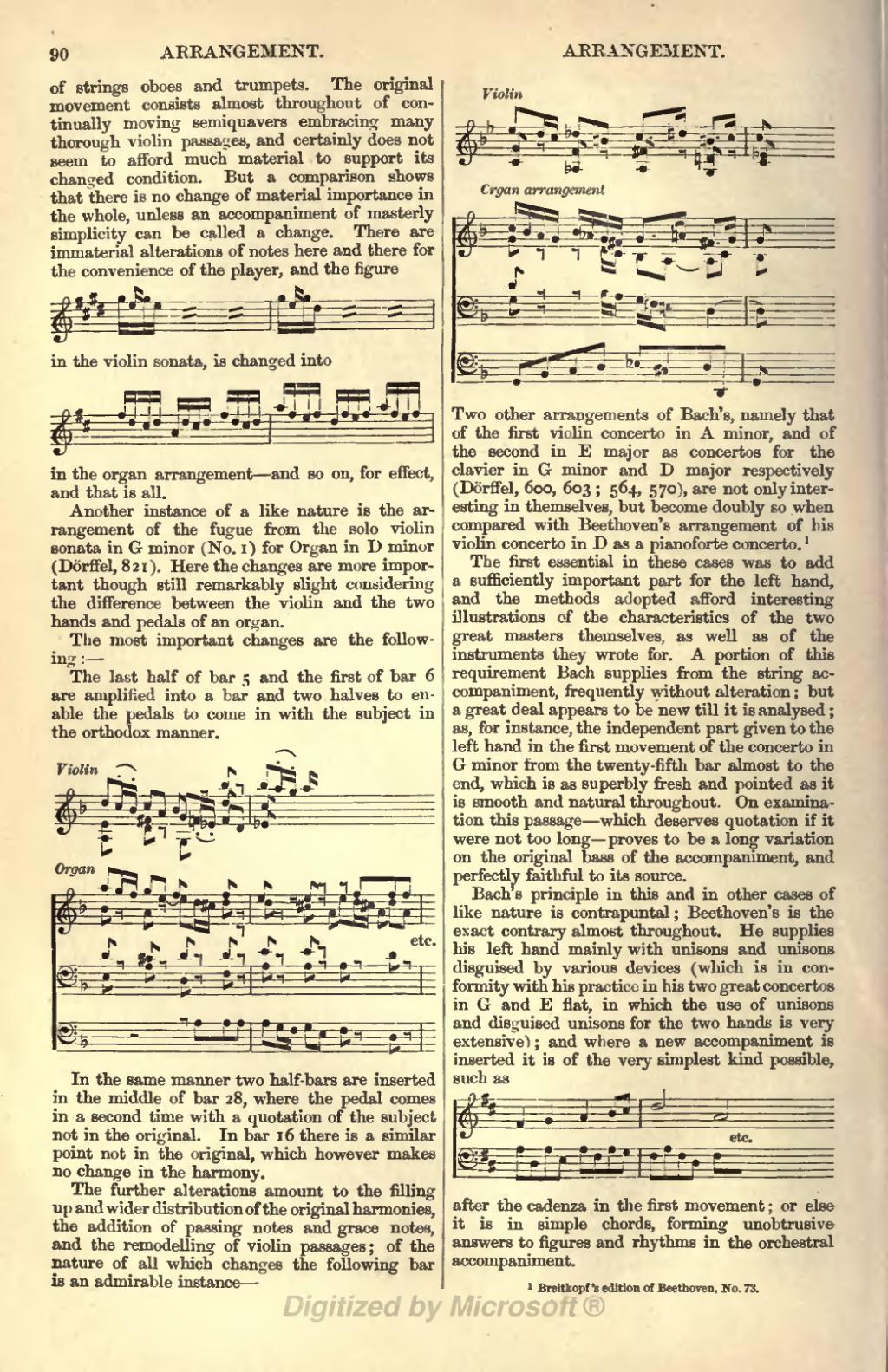of strings oboes and trumpets. The original movement consists almost throughout of continually moving semiquavers embracing many thorough violin passages, and certainly does not seem to afford much material to support its changed condition. But a comparison shows that there is no change of material importance in the whole, unless an accompaniment of masterly simplicity can be called a change. There are immaterial alterations of notes here and there for the convenience of the player, and the figure
![{ \override Score.TimeSignature #'stencil = ##f \time 3/4 \key e \major \relative g'' << { s16 e s8 s2 | s16 e } \\ { \repeat percent 3 { gis16[ s gis e] } | \repeat percent 3 { gis16[ s gis dis] } } >> }](http://upload.wikimedia.org/score/q/7/q75jz70lmlj3lkpliubma3yk32uqu6t/q75jz70l.png)
in the violin sonata, is changed into

in the organ arrangement and so on, for effect, and that is all.
Another instance of a like nature is the arrangement of the fugue from the solo violin sonata in G minor (No. 1) for Organ in D minor (Dörffel, 821). Here the changes are more important though still remarkably slight considering the difference between the violin and the two hands and pedals of an organ.
The most important changes are the following:—
The last half of bar 5 and the first of bar 6 are amplified into a bar and two halves to enable the pedals to come in with the subject in the orthodox manner.


In the same manner two half-bars are inserted in the middle of bar 28, where the pedal comes in a second time with a quotation of the subject not in the original. In bar 16 there is a similar point not in the original, which however makes no change in the harmony.
The further alterations amount to the filling up and wider distribution of the original harmonies, the addition of passing notes and grace notes, and the remodelling of violin passages; of the nature of all which changes the following bar is an admirable instance—


Two other arrangements of Bach's, namely that of the first violin concerto in A minor, and of the second in E major as concertos for the clavier in G minor and D major respectively (Dörffel, 600, 603; 564, 570), are not only interesting in themselves, but become doubly so when compared with Beethoven's arrangement of his violin concerto in D as a pianoforte concerto.[1]
The first essential in these cases was to add a sufficiently important part for the left hand, and the methods adopted afford interesting illustrations of the characteristics of the two great masters themselves, as well as of the instruments they wrote for. A portion of this requirement Bach supplies from the string accompaniment, frequently without alteration; but a great deal appears to be new till it is analysed; as, for instance, the independent part given to the left hand in the first movement of the concerto in G minor from the twenty-fifth bar almost to the end, which is as superbly fresh and pointed as it is smooth and natural throughout. On examination this passage—which deserves quotation if it were not too long—proves to be a long variation on the original bass of the accompaniment, and perfectly faithful to its source.
Bach's principle in this and in other cases of like nature is contrapuntal; Beethoven's is the exact contrary almost throughout. He supplies his left hand mainly with unisons and unisons disguised by various devices (which is in conformity with his practice in his two great concertos in G and E flat, in which the use of unisons and disguised unisons for the two hands is very extensive); and where a new accompaniment is inserted it is of the very simplest kind possible, such as

after the cadenza in the first movement; or else it is in simple chords, forming unobtrusive answers to figures and rhythms in the orchestral accompaniment.
- ↑ Breitkopf's edition of Beethoven, No. 73.

